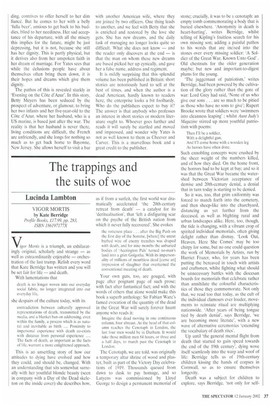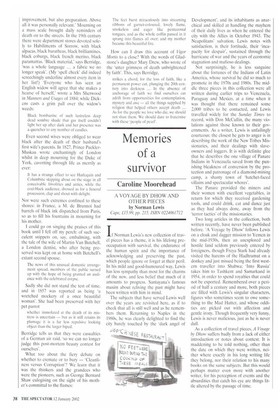The trappings and the suits of woe
Lucinda Lambton
VIGOR MORTIS by Kate Berridge Profile Books, £17.99, pp. 283, ISBN 186197177X Vigor Mortis is a triumph, an exhilaratingly original, scholarly and strange — as well as extraordinarily enjoyable — orchestration of the last trump. Relish every word that Kate Berridge has written and you will be set fair for life — and death.
With lamentations that
death is no longer woven into our everyday social fabric, no longer integrated into our everyday life,
she despairs of the culture today, with its
contradiction between culturally approved representations of death, transmitted by the media, and a blanket ban on addressing, even within the family, a process which is as natural and inevitable as birth .... Proximity to impersonal experience with death co-exists with distance from personal experience .... The facts of death, as important as the facts of life, warrant a more enlightened approach.
This is an unsettling story of how our attitudes to dying have evolved and how they could, and should be, changed. With an understanding that sits somewhat surreally with her youthful blonde beauty (seen in company with a Day of the Dead skeleton on the inside cover) she describes how,
as if from a surfeit, the first world war dramatically accelerated the 20th-century retreat from death' — a catalyst for its `deritualisation', that 'left a disfiguring scar on the psyche of the British nation from which it never fully recovered'. She evokes
the rottenest place . . . after the Big Push on the first day of the Somme, [where] the uncut barbed wire of enemy trenches was draped with death, and for nine months the unburied bodies of 'Accrington Pals' turned no-man's land into a grim Golgotha. With its impersonality of millions of mouthless dead [came an] impression of slaughter that overturned the conventional meaning of death.
Your own guts, too, are gouged, with page after poignant page of such prose; with fact after fantastical fact; and with the words of others that alone would make this book a superb anthology: Sir Fabian Ware's famed evocation of the quantity of the dead in the Great War will surely forever haunt anyone who reads it:
Imagine the dead moving in one continuous column, four abreast. As the head of that column reaches the Cenotaph in London, the last four men would be in Durham. It would take those million men 84 hours, or three and a half days, to march past the Cenotaph in London.
The Cenotaph, we are told, was originally a temporary altar shrine of wood and plaster, built as part of the Victory Day celebrations of 1919. Thousands queued from dawn to dusk to pay homage, and so LuVens was commissioned by Lloyd George to design a permanent memorial of stone; crucially, it was to be a cenotaph: an empty tomb commemorating a body that is buried elsewhere. 'Anonymity in death is heart-hurting'. writes Berridge, whilst telling of Kipling-s fruitless search for his own missing son; adding a painful pathos to his words that are incised into the stones over every missing soldier: 'A Soldier of the Great War, Known Unto God'. Old chestnuts for the older generation maybe; but new and important-to-digest plums for the young.
'The juggernaut of patriotism,' writes Berridge, had been powered by the cultivation of the glory rather than the gore of war: Lord Grey had said, 'None of us who give our sons.. . are so much to be pitied as those who have no sons to give'; Rupert Brooke wrote that soldiers were 'swimmers into cleanness leaping' ; whilst Aunt Judy's Magazine stirred up more youthful patriotism with poems:
Then I'll be a soldier,
With a delightful gun, And I'll come home with a wooden leg As heroes have often done.
Such ennobling concepts were crushed by the sheer weight of the numbers killed, and of how they died. On the home front, the horrors had to be kept at bay; and so it was that the Great War became the watershed between Victorian acceptance of demise and 20th-century denial, a denial that in turn today is starting to be denied.
So it was, too, that grim uniformity was forced to march forth into the cemetery, and then sheep-like into the churchyard, distancing us yet further from the deceased, as well as blighting rural and urban landscapes alike. Here, too, though, the tide is changing, with a vibrant crop of spirited individual memorials, often giving delight rather than dismay. 'Look Out, Heaven, Here She Comes' may be too chirpy for some, but no one could question the work of Memorials by Artists, run by Harriet Frazer, who, for years has been putting the bereaved in touch with artists and craftsmen, whilst fighting what should be unnecessary battles with the diocesan boards for memorials that celebrate rather than annihilate the colourful characteristics of those they commemorate. Not only that, we read too that today, as the cult of the individual clamours ever louder, movements to reinstate ritual are multiplying nationwide. 'After years of being tongue tied by death denial', says Berridge, 'we are becoming more literate', with a new wave of alternative ceremonies 'extending the vocabulary of death rites-.
Up until 'the general mental flight from death that started to gain speed towards the end of the 19th century', dying wove itself seamlessly into the warp and woof of life: Berridge tells us of 19th-century children kissing the hands of corpses in Cornwall, so as to ensure themselves longevity.
Death was a subject for children to explore, says Berridge, 'not only for self
improvement, but also preparation. Above all it was personally relevant.' Mourning on a mass scale brought daily reminders of death on to the streets. In the 19th century there were department stores devoted solely to Habiliments of Sorrow, with black alpacas, black baratheas, black brilliantines, black coburgs, black french merino, black paramattas. 'Black material,' says Berridge, was a whole language ... a fabric we no longer speak'. (My 'spell check' did indeed screechingly underline almost every item in her list!) 'Everyone who has seen an English widow will agree that she makes a hearse of herself,' wrote a Mrs Sherwood in Manners and Usages of 1884; while Dickens casts a grim pall over the widow's weeds:
Black bombazine of such lustreless deep dead sombre shade that gas itself couldn't light her up after dark and her presence was a quencher to any number of candles.
Even second wives were obliged to wear black after the death of their husband's first wife's parents. In 1827, Prince PucklerMuskau wrote enchantingly of London whilst in deep mourning for the Duke of York, cavorting through life as merrily as ever:
It has a strange effect to see Harlequin and Columbine skipping about on the stave in all conceivable frivolities and antics, while the coal-black audience, dressed as for a funeral procession. clap and shout with delight.
Nor were such extremes confined to these shores: in France, a M. de Brunnoi had barrels of black ink dispatched from Paris, so as to fill his fountains in mourning for his mother.
I could go on singing the praises of this book until I fell off my perch: of such succulent snippets on, say, embalming, with the tale of the wife of Martin Van Butchell, a London dentist, who after being preserved was kept on at home with Butchell's extant second spouse.
The news of this unusual domestic arrangement spread, members of the public turned up with the hope of being granted an audience with the celebrated corpse.
Sadly she did not stand the test of time, and in 1857 was reported as being 'a wretched mockery of a once beautiful woman'. She had been preserved with her pet parrot
whether immolated at the death of its mistress is uncertain — but as it still retains its plumage it is a far less repulsive looking object than the larger biped.
Berridge tells us that they were casualties of a German air raid, 'so we can no longer judge this post-mortem beauty contest for ourselves'.
What too about the fiery debate on whether to cremate or to bury — 'Cleanliness versus Corruption'? We learn that it was the thinkers and the grandees who were the pioneers, such as George Bernard Shaw eulogising on the sight of his mother's committal to the flames:
The feet burst miraculously into streaming ribbons of garnet-coloured, lovely flame, smokeless and eager like pentecostal tongues, and as the whole coffin passed in it sprang into flames all over; and my mother became this beautiful fire.
How can I draw this account of Vigor Mortis to a close? With the words of Gladstone's daughter Mary Drew, who wrote of the 'utter grimness of death unbrightened by faith'. This, says Berridge,
strikes a chord, for the loss of faith, like a permanent power cut, plunging the 20th century into darkness .... In the absence of anchorage of faith we find ourselves cut adrift from opportunities for contemplation, mystery and awe — all the things supplied by religion that helped others accept death .... As for the people we love who die, we should not shun them. We should dare to fraternise with these `people of pearl'.



























































 Previous page
Previous page